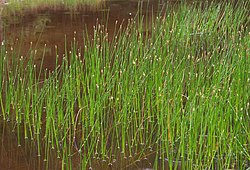Species of grass-like plant
"Common spikerush" redirects here. For the Australian plant, see
Eleocharis acuta .
Eleocharis palustris Scientific classification Kingdom: Plantae Clade : Tracheophytes Clade : Angiosperms Clade : Monocots Clade : Commelinids Order: Poales Family: Cyperaceae Genus: Eleocharis Species: E. palustris
Binomial name Eleocharis palustris Synonyms [ 2] Bulbostylis palustris (L.) Steven Chlorocharis palustris (L.) Rikli Clavula palustris (L.) Dumort. Cyperus paluster Missbach & E.H.L.Krause Cyperus paluster var. uniglumoides E.H.L.Krause Cyperus palustris (L.) Sessé & Moc. Eleocharis appendiculata Phil. Eleocharis boissieri Podp. Eleocharis ecarinata Zinserl. Eleocharis filiculmis Schur Eleocharis glaucescens (Willd.) Schult. Eleocharis globularis Zinserl. Eleocharis gracilis Hayek Eleocharis haematolepis Steud. Eleocharis intersita f. acetosa Tang & F.T.Wang ex Y.L.Chang Eleocharis kasakstanica Zinserl. Eleocharis kitamurana T.Koyama Eleocharis levinae Zoz Eleocharis limosa Drège Eleocharis lindbergii (Strandh.) Tzvelev Eleocharis minima f. major Boeckeler Eleocharis minima var. mexicensis H.Pfeiff. Eleocharis nebrodensis Parl. Eleocharis oxystachys Sakalo Eleocharis palustris var. degenerata Hook. Eleocharis palustris subsp. globularis (Zinserl.) T.V.Egorova Eleocharis palustris var. globularis (Zinserl.) A.E.Kozhevn. Eleocharis palustris subsp. intersita (Zinserl.) Tzvelev Eleocharis palustris var. kurilensis A.E.Kozhevn. Eleocharis palustris var. lindbergii Strandh. Eleocharis palustris subsp. lindbergii (Strandh.) Tzvelev Eleocharis palustris var. major Sond. Eleocharis palustris var. minor Hook. Eleocharis palustris subsp. vigens (L.H.Bailey) A.Haines Eleocharis palustris subsp. vulgaris Walters Eleocharis palustromicrocarpa Á.Löve Eleocharis quaesita Kitag. Eleocharis smallii Britton Eleocharis smallii var. major (Sond.) F.Seym. Eleocharis striata Hochst. ex Engl. Eleocharis vulgaris Á.Löve & D.Löve Limnochloa capensis Nees Megadenus palustris (L.) Raf. Schoenus palustris (L.) Bernh. Scirpus acicularis Oeder Scirpus appendiculatus (Phil.) Kuntze Scirpus baeothryon Schrad. Scirpus bailii Kohts Scirpus caespitosus Willd. ex Kunth Scirpus campestris Willd. ex Kunth Scirpus conicus C.Presl ex Mert. & W.D.J.Koch Scirpus glaucescens Willd. Scirpus intermedius Thuill. Scirpus ovatus Gilib. Scirpus palustris L. Scirpus palustromicrocarpus (Á.Löve) Á.Löve Scirpus reptans Thuill. Scirpus tenuis Schreb. ex Schweigg. & Körte Scirpus varius Schreb. ex Schweigg. & Körte Trichophyllum palustre (L.) House Trichophyllum palustre var. glaucescens (Willd.) House Trichophyllum palustre var. vigens (L.H.Bailey) House
Eleocharis palustris common spike-rush , creeping spike-rush or marsh spike-rush , is a species of mat-forming perennial flowering plants in the sedge family Cyperaceae . It grows in wetlands in Europe , North Africa , northern and central Asia (Siberia , China , Mongolia , Iran , Nepal , etc.) and North America (United States , Canada , Greenland , northern Mexico ). [ 3] [ 4] [ 5] [ 6] [ 7] [ 8] Eleocharis palustris is not easily distinguished from other closely related species and is extremely variable worldwide itself. The species epithet palustris is Latin for "of the marsh" and indicates its common habitat. [ 9]
This page is based on this
Wikipedia article Text is available under the
CC BY-SA 4.0 license; additional terms may apply.
Images, videos and audio are available under their respective licenses.


